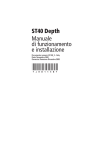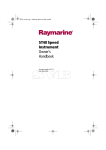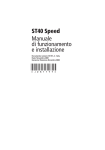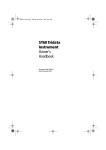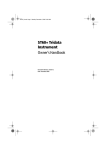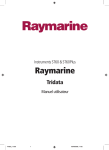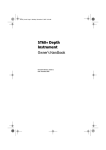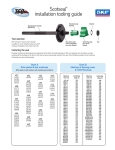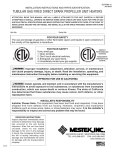Download Raymarine ST40 Product specifications
Transcript
Distributed by Any reference to Raytheon or RTN in this manual should be interpreted as Raymarine. The names Raytheon and RTN are owned by the Raytheon Company. ST40 Depth Instrument Owner’s Handbook Document number: 81158_2 Date: 1st May 2001 158_2cov.p65 1 01/05/01, 13:55 Copyright © Raymarine Limited 2001 158_2cov.p65 2 01/05/01, 13:55 i Preface Important information WARNING Although your ST40 instrument is designed to give accurate and reliable performance, it should serve only as an aid to navigation and should never lead to the erosion of good seamanship. Always maintain a permanent watch and be aware of situations as they develop. EMC conformance All Raymarine equipment and accessories are designed to the best industry standards for use in the leisure marine environment. The design and manufacture of Raymarine equipment and accessories conform to the appropriate Electromagnetic Compatibility (EMC) standards, but correct installation is required to ensure that performance is not compromised. Handbook information To the best of our knowledge, the information in this handbook was correct when it went to press. However, the Raymarine policy of continuous product improvement may change product specifications without notice. Consequently, unavoidable differences may occur between the product and the handbook from time to time, for which Raymarine cannot accept liability. 158_2pre.p65 1 01/05/01, 13:55 ii 158_2pre.p65 ST40 Depth Instrument Owner’s Handbook 2 01/05/01, 13:55 iii Preface Contents Important information .......................................................... i WARNING ......................................................................... i EMC conformance ............................................................. i Handbook information ....................................................... i Preface ..................................................................................... v Parts supplied ................................................................... vi Chapter 1: Operation ............................................................. 1 1.1 Operating procedures .................................................. 1 Silencing alarms .......................................................... 1 Adjusting display backlighting and contrast ............... 4 1.2 Alarms ......................................................................... 5 Alarm indications ........................................................ 5 Shallow alarm ........................................................ 5 Deep alarm ............................................................. 5 Anchor alarms ........................................................ 5 Enabling/disabling alarms ........................................... 6 Chapter 2: Maintenance and Fault Finding ........................ 7 2.1 Maintenance ................................................................ 7 Servicing and safety .................................................... 7 Instrument .................................................................... 8 Transducer ................................................................... 8 Cabling ........................................................................ 8 2.2 Fault finding ................................................................ 8 Preliminary procedures ............................................... 8 Fixing faults ................................................................. 8 Assistance .................................................................. 10 158_2pre.p65 3 01/05/01, 13:55 iv ST40 Depth Instrument Owner’s Handbook Chapter 3: Installation ......................................................... 11 3.1 Planning your installation ......................................... 11 EMC installation guidelines ...................................... 11 Suppression Ferrites ........................................... 12 Connections to Other Equipment ......................... 12 Tools required ........................................................... 12 Site requirements ....................................................... 13 Transducer ........................................................... 13 Instrument ............................................................ 15 3.2 Procedures ................................................................. 16 Fitting transducer ....................................................... 16 Running transducer cable .................................... 16 Connections to the instrument ................................... 17 SeaTalk connections ............................................ 18 Fitting the instrument ................................................. 19 Desktop Mounting Bracket .................................. 21 3.3 Calibration requirement ............................................ 22 Chapter 4: Calibration ......................................................... 23 4.1 Introduction ............................................................... 23 EMC conformance .................................................... 23 4.2 User calibration ......................................................... 23 Depth offsets ............................................................. 24 4.3 Intermediate calibration ............................................ 26 4.4 Dealer calibration ...................................................... 26 Instrument Specification .................................................... 29 Glossary ................................................................................. 31 Index ...................................................................................... 33 158_2pre.p65 4 01/05/01, 13:55 v Preface Preface Thank you for purchasing a Raymarine product. We are sure your ST40 instrument will give you many years of trouble-free operation. This instrument is designed to provide reliable performance, even under the most demanding conditions. D46 158_2pre.p65 5 01/05/01, 13:55 37-2 vi ST40 Depth Instrument Owner’s Handbook Parts supplied DEPTH ST40 ST40 Depth instrument Instrument Cover 1 m (3 ft) power cable Gasket Fixing stud Thumb nut Depth transducer Supplied with bung (not illustrated) Clamping bracket ST40 Depth Instrument - quick reference guide Normal operation SWITCH ON Depth ST40 Depth Instrument Owner's Handbook Worldwide Distributors Minimum depth Alarm on/off Shallow alarm 3 seconds Alarm on/off Deep alarm 3 seconds + Set alarm level Alarm on/off Shallow anchor alarm 3 seconds - With Set alarm level screen displayed, press the and keys simultaneously to save the alarm level and return to normal operation. Alarm on/off Deep anchor alarm 3 seconds Notes: *denotes temporary screens which will time-out to the previous permanent screen after 5 seconds. Offset On repeater instruments, only the Depth and Minimum depth screens are available. Adjusting display backlighting/contrast To enter adjust mode, press OFF for 1 second to adjust BACKLIGHTING and a further 1 second to adjust CONTRAST LEVEL 1 LEVEL 2 To exit adjust mode press Worldwide Service Centre Handbook. Owner’s Handbook. Warranty document and fitting templates included in Handbook LEVEL 3 or LEVEL 2 LEVEL 1 or wait for 5 second timeout Quick Reference Guide Note: The items shown here are supplied for an ST40 Depth system. If an instrument is purchased separately, a transducer is not included. If any item is not present, contact your Raymarine Dealer. D4665-2 158_2pre.p65 6 01/05/01, 13:56 1 Chapter 1: Operation Chapter 1: Operation Your ST40 Depth instrument: • Provides depth information, in either feet (FT), metres (M) or fathoms (FA), as set during User calibration (see Chapter 4, Calibration). • Records the minimum depth encountered during the period it is switched on. You can reset this at any time. • Enables you to define alarm thresholds for shallow water, deep water, shallow anchor and deep anchor. • Enables you to see what offset is applied to the depth reading. CAUTION Your instrument is calibrated to factory (default) settings when first supplied and must therefore be calibrated before use, to ensure optimum performance on your vessel. Do NOT use the instrument until the calibration procedures have been satisfactorily completed, using the procedures in Chapter 4, Calibration. Coloured bezel and Desktop Mounting Bracket options are available for your ST40 instrument. Contact your Raymarine dealer for further information. 1.1 Operating procedures Operating information is presented in flow chart form. The flow charts show the various operating screens and key presses necessary to carry out the various instrument functions. Key presses are momentary unless otherwise stated. Note that: • Up/down depth-trend arrows are displayed, if the seabed is rising or falling at a significant rate. • The minimum depth reading is reset to zero at power up. Silencing alarms To silence an alarm (see the Alarms section, later in this chapter), momentarily press any one of the instrument keys. 158_2c01.p65 1 01/05/01, 13:56 2 ST40 Depth Instrument Owner’s Handbook NORMAL OPERATION (sheet 1) Switch on Depth To/from the Offset screen (sheet 2) Minimum depth Notes: Screens other than the Depth screen, are temporary and will time-out to the Depth screen after 5 seconds. To reset 3 seconds This diagram shows the operating sequence for an ST40 Depth master instrument. On a repeater instrument, only the Depth and Minimum depth screens are available. With any set alarm screen displayed, press the and keys simultaneously to save the alarm level and return to normal operation. Alarm on/off Shallow alarm Set Shallow alarm threshold 3 seconds Increase + Momentary If the Shallow alarm has been locked during User calibration, you cannot switch it on or off or change the threshold value. Decrease Alarm on/off Deep alarm Set Deep alarm threshold 3 seconds Increase + Momentary Decrease To/from Shallow anchor alarm screen (sheet 2) D4658-2 158_2c01.p65 2 01/05/01, 13:56 3 Chapter 1: Operation NORMAL OPERATION (sheet 2) To/from Deep alarm screen (sheet 1) Shallow anchor alarm Alarm on/off ST40 DEPTH Set Shallow anchor alarm threshold 3 seconds Increase ST40 DEPTH + Momentary Decrease Deep anchor alarm Alarm on/off ST40 DEPTH Set Deep anchor alarm threshold 3 seconds Increase ST40 DEPTH + Momentary Decrease Offset ST40 DEPTH (+ve values) (offset = 0.0) (-ve values) To/from Depth screen (sheet 1) Note: Screens other than the Depth screen, are temporary and will time-out to the Depth screen after 5 seconds. D4659-2 158_2c01.p65 3 01/05/01, 13:56 4 ST40 Depth Instrument Owner’s Handbook Adjusting display backlighting and contrast Hold down for 1 second to enter Adjust Backlight mode for 2 seconds to move through Adjust Backlight mode and enter Adjust Contrast mode ADJUST BACKLIGHTING During normal operation, press for 1 second The current backlighting level is displayed. Select the required backlighting level then: to adjust contrast, press for 1 second to return to normal operation, or press or wait for 5 second timeout Normal operation ADJUST CONTRAST During normal operation, press for 2 seconds via Adjust Backlighting The current contrast level is displayed. Select the required contrast level then press or or wait for 5 second timeout Normal operation 158_2c01.p65 4 D4845-1 01/05/01, 13:56 5 Chapter 1: Operation 1.2 Alarms Alarm indications Shallow alarm Depth is equal to or less than the shallow alarm threshold. Alarm continues until cancelled manually. D4786-2 Deep alarm Triggered by depths equal to the deep alarm threshold. Continues until cancelled manually. D4787-2 Anchor alarms Depth is either: equal to or less than the shallow anchor alarm threshold or equal to or more than the deep anchor alarm threshold D4788-2 158_2c01.p65 5 01/05/01, 13:56 6 ST40 Depth Instrument Owner’s Handbook Enabling/disabling alarms You can enable or disable any alarm function (i.e. switch it on or off ) by selecting the relevant alarm screen (see Normal operation) and holding down the key for 3 seconds (toggle action). 158_2c01.p65 6 01/05/01, 13:56 7 Chapter 2: Maintenance and Fault Finding Chapter 2: Maintenance and Fault Finding 2.1 Maintenance Servicing and safety • Raymarine equipment should be serviced only by authorised Raymarine service technicians. They will ensure that service procedures and replacement parts used will not affect performance. There are no user-serviceable parts in any Raymarine product. • Some products generate high voltages, so never handle the cables/ connectors when power is being supplied to the equipment. • When powered up, all electrical equipment produces electromagnetic fields. These can cause adjacent pieces of electrical equipment to interact with one another, with a consequent adverse affect on operation. In order to minimise these effects and enable you to get the best possible performance from your Raymarine equipment, guidelines are given in the installation instructions, to enable you to ensure minimum interaction between different items of equipment, i.e. ensure optimum Electromagnetic Compatibility (EMC). • Always report any EMC-related problem to your nearest Raymarine dealer. We will use any such information to improve our quality standards. • In some installations, it may not be possible to prevent the equipment from being affected by external influences. In general this will not damage the equipment but it can lead to spurious resetting action, or momentarily may result in faulty operation. • Always switch off the power to Raymarine equipment before working on it. When requesting service, please quote equipment Type, Model Number, Serial Number and, if possible, Software Release Issue. The Software Release Issue can be ascertained by means of the Intermediate Calibration facility, see Chapter 4, Calibration. 158_2c02.p65 7 01/05/01, 13:56 8 ST40 Depth Instrument Owner’s Handbook Instrument Certain atmospheric conditions may cause a small amount of condensation to form on the instrument window. This will not harm the instrument and will clear after the instrument has been switched on for a short period. Periodically clean your ST40 instrument with a soft damp cloth. Do NOT use chemical or abrasive materials to clean the instrument. Transducer Refer to the Installation and Maintenance instructions supplied with the transducer. Cabling Examine all cables for chafing or other damage to the outer shield and, where necessary, replace and re-secure. 2.2 Fault finding Preliminary procedures If you appear to have a problem, first check the security of the connections at the rear of the instrument and reconnect any that are loose. Changes in the electronic environment may adversely affect the operation of your ST40 equipment. Typical examples of such changes are: • Electrical equipment has recently been installed or moved aboard your vessel. • You are in the vicinity of another vessel or shore station emitting radio signals. Fixing faults All Raymarine products are subjected to comprehensive test and quality assurance programmes prior to packing and shipping. However, if a fault occurs, the following guidelines may help to identify and rectify the problem. 158_2c02.p65 8 01/05/01, 13:56 9 Chapter 2: Maintenance and Fault Finding Action Low battery Recharge your vessel’s battery as soon as possible DEPTH D4735-2 Display blank Action Check fuse/circuit breaker. Check power supply. ST40 DEPTH D4736-2 Depth reading flashes when under way Check SeaTalk cabling and connector security. Action Ensure that reading stabilises when clear of disturbed water, e.g. boat wakes, propeller wash etc. ST40 DEPTH D4661-2 Action No depth information Check the condition of the transducer cable and the security of the connections. ST40 DEPTH This symptom could also be caused by weed on the transducer face. 1 minute ST40 158_2c02.p65 DEPTH D4660-2 9 01/05/01, 13:56 10 ST40 Depth Instrument Owner’s Handbook SeaTalk information not being transferred between instruments For example, backlighting level changes implemented at one instrument do not affect other instruments Action Check security of SeaTalk connections between instruments. Check condition of SeaTalk cables. Isolate faulty instrument by disconnecting instruments one by one. Action A group of SeaTalk instruments not working ST40 SPEED ST40 SPEED ST40 SPEED Check the security of SeaTalk connectors between functioning and non-functioning instruments. D4642-2 Assistance If you are unable to rectify any problem, please contact your local Raymarine Dealer for assistance. 158_2c02.p65 10 01/05/01, 13:56 11 Chapter 3: Installation Chapter 3: Installation This chapter describes how to install the ST40 Depth instrument, and associated Depth transducer. The transducer is fitted in the hull of the vessel and is connected to the rear of the instrument. 3.1 Planning your installation Determine the best positions for both transducer and instrument, such that the EMC installation guidelines and the Site requirements (below) are satisfied. EMC installation guidelines All Raymarine equipment and accessories are designed to the best industry standards for use in the leisure marine environment. Their design and manufacture conform to the appropriate Electromagnetic Compatibility (EMC) standards, but correct installation is required to ensure that performance is not compromised. Although every effort has been taken to ensure that they will perform under all conditions, it is important to understand what factors could affect the operation of the product. The guidelines given here describe the conditions for optimum EMC performance, but it is recognised that it may not be possible to meet all of these conditions in all situations. To ensure the best possible conditions for EMC performance within the constraints imposed by any location, always ensure the maximum separation possible between different items of electrical equipment. For optimum EMC performance, it is recommended that wherever possible: • All Raymarine equipment and cables connected to it are: • At least 1 m (3 feet) from any equipment transmitting or cables carrying radio signals e.g. VHF radios, cables and antennas. In the case of SSB radios, the distance should be increased to 2 m (7 ft). • More than 2 m (7 ft) from the path of a radar beam. A radar beam can normally be assumed to spread 20 degrees above and below the radiating element. 158_2c03.p65 11 01/05/01, 13:56 12 ST40 Depth Instrument Owner’s Handbook • The equipment is supplied from a different battery from that used for engine start. Voltage drops below 10 V in the power supply to our products, and starter motor transients, can cause the equipment to reset. This will not damage the equipment, but may cause the loss of some information and may change the operating mode. • Raymarine specified cables are used at all times. Cutting and rejoining these cables can compromise EMC performance and so must be avoided unless doing so is detailed in the installation manual. • If a suppression ferrite is attached to a cable, this ferrite should not be removed. If the ferrite needs to be removed during installation it must be reassembled in the same position. Suppression Ferrites The following illustration shows typical cable suppression ferrites fitted to Raymarine equipment. Always use the ferrites supplied by Raymarine. D3548-2 Connections to Other Equipment If your Raymarine equipment is going to be connected to other equipment using a cable not supplied by Raymarine, a suppression ferrite MUST always be fitted to the cable close to the Raymarine unit. Tools required The tools required for fitting the standard ST40 instrument system are shown in the following illustration. 158_2c03.p65 12 01/05/01, 13:56 13 Chapter 3: Installation 57 mm (2.25 in) 51 mm (2.0 in) D4643-1 Note: If you intend fitting a nonstandard transducer, extra tools may be required Site requirements Transducer The transducer types required for the various hull types are as follows: Hull material Transducer type Glass reinforced plastic (GRP) Steel Aluminium M78713 Through hull plastic (supplied as standard) or M78718 Retractable through hull Wood M78714 Through hull bronze Other transducer types are also available for specific requirements. For further details, contact your local Raymarine dealer. 89 mm (3.50 in) 75 mm (2.94 in) diameter 51 mm (2.0 in) diameter 75 mm (2.94 in) 5mm (0.19 in) diameter Plastic through-hull depth transducer dimensions 158_2c03.p65 13 01/05/01, 13:56 D4445-2 14 ST40 Depth Instrument Owner’s Handbook The transducer should be sited within the clear water flow areas indicated by the shaded areas in the following illustration. Sailing vessel Planing power vessel Displacement power vessel Transducer siting D4349-1 The transducer should also: • Be ahead of the propellers (by a minimum of 10% of the water line length ). • Be at least 150 mm (6 in) away from the keel (ideally ahead of the keel if a sailing yacht). • Be as near as possible to the centre line of the vessel. • Be clear of other through-hull fittings or projections. • Have sufficient clearance inside the hull to fit the nut. • Have 100 mm (4 in) of headroom to allow for withdrawal. In addition to the above requirements, the depth transducer must be mounted within 100 of the vertical, forward, aft and athwart ships. 158_2c03.p65 14 01/05/01, 13:56 15 Chapter 3: Installation Depth transducer maximum angle D4350-2 Instrument CAUTION: The presence of moisture at the rear of the instrument could cause damage either by entering the instrument through the breathing hole or by coming into contact with the electrical connectors. 55 mm (2.2 in) 70 mm (2.8 in) ST40 30 mm (1.2 in) minimum cable clearance 126 mm (5.0 in) Instrument dimensions 21 mm (0.8 in) 17 mm (0.67 in) Each instrument must be positioned where: • It is easily read by the helmsman or navigator • It is protected against physical damage • It is at least 230 mm (9 in) from a compass • There is reasonable rear access for installation and servicing • The rear of the instrument is protected from water. 158_2c03.p65 15 01/05/01, 13:56 D4644-2 16 ST40 Depth Instrument Owner’s Handbook 3.2 Procedures Adapt these procedures as appropriate, to suit your individual requirement. CAUTION: Where it is necessary to cut holes (e.g. for cable routing and instrument mounting), ensure that these will not cause a hazard by weakening critical parts of the vessel’s structure. If in doubt, seek advice from a reputable boat builder. Fitting transducer Instructions for installing and maintaining the depth transducer are packed with it. Before attempting to install the transducer, read these instructions and the Site requirements for transducers described in this Chapter. Running transducer cable Each transducer type has a 9 m (30 ft) cable fitted with spade terminals for connection to the ST40 Depth instrument. Observing the following guidelines, run the cable to the instrument: • If the cable has to be fed through the deck, always use a good quality deck gland. • Where cables are fed through holes, always use grommets to prevent chafing. • Secure long cable runs so they do not present a hazard. • Wherever possible, route the cable away from fluorescent lights, engines, radio transmitting equipment, as these may cause interference. Important point: Do NOT shorten the cable from the depth transducer as this will seriously degrade transducer performance. 158_2c03.p65 16 01/05/01, 13:56 17 Chapter 3: Installation Connections to the instrument You can connect your instrument: • Directly to the depth transducer as a stand-alone master instrument. When connected in this manner, the instrument must be connected to a suitable power source using the 1 m (3 ft) power cable provided. • As part of a SeaTalk system either as a repeater or, with a transducer also connected as a system master. To connect to SeaTalk, you will need an additional SeaTalk Interconnection Kit (Part No. E25028). When connected in this manner, power can be provided from the SeaTalk bus (e.g. from the autopilot). You can also connect the instrument to both the depth transducer and SeaTalk. When thus connected, the instrument will be the master depth instrument for the SeaTalk system. If it is necessary to fit spade connectors to the transducer cable, do so as shown in the following illustration. Prepare the cable, as at (a), and fit the spade connectors, as at (b). When fitting each spade connector, ensure that wire strands do not extend beyond the rear of the spade connector insulation. 10 mm 50 mm (a) 4 mm (b) 3 mm Preparing wires for connection 158_2c03.p65 17 D4467-3 01/05/01, 13:56 18 ST40 Depth Instrument Owner’s Handbook Stand-alone connections CAUTION Ensure that the power supply for each stand-alone ST40 instrument is protected by a 3 A fuse or circuit breaker. 3 A circuit breaker Red +ve Note: A 3 A fuse can be used in place of the circuit breaker, if preferred. Uninsulated wire (screen) -ve 12 V dc supply (e.g. battery) Power cable Screen Blue Black _ + Cable from Depth transducer Connections to a stand-alone instrument D4785-2 SeaTalk connections CAUTION When instruments are connected to SeaTalk, ensure that the power supply for the SeaTalk 12 V line is protected by a 5 A fuse or circuit breaker. 158_2c03.p65 18 01/05/01, 13:56 19 Chapter 3: Installation Note: A 5 A fuse can be used in place of the circuit breaker, if preferred. 5 A circuit breaker Red (+ve) 12 V dc supply (e.g. course computer or battery) Uninsulated wire (screen) -ve Power cable SeaTalk bus SeaTalk bus SeaTalk interface kit Typical SeaTalk connections D4824-2 Fitting the instrument Fit your ST40 instrument as shown in the following illustrations. 1 Remove template from handbook (immediately after index), apply to required location and mark cutting centre. ST4 0 In stru me nt Tem pla te TOP sha Cut ded out are ao nly Cutting centre Cut 57 out h diamm (2ole me .25 ter in ) D4759-1 158_2c03.p65 19 01/05/01, 13:56 20 ST40 Depth Instrument Owner’s Handbook 2 Cut hole 57 mm (2.25 in) cutter D4760-1 3 Peel protective sheets from gasket D4770-1 4 Stick gasket to rear of instrument D4761-1 158_2c03.p65 20 01/05/01, 13:56 21 Chapter 3: Installation 5 Screw stud into instrument D4819-1 6 5 Feed cables through clamping bracket, connect cables then secure instrument with Fit instrument bracket and thumb nut D4817-1 Desktop Mounting Bracket An optional Desktop Mounting Bracket (Part No. E25024) enables you to mount your ST40 instrument in locations where other forms of mounting are impractical. 158_2c03.p65 21 01/05/01, 13:56 22 ST40 Depth Instrument Owner’s Handbook D4646-1 To bracket mount your ST40 instrument, do so in accordance with the Instruction Sheet, which is included with the Desktop Mounting Bracket. 3.3 Calibration requirement Once installation is complete and before you use your instrument, carry out the calibration procedures detailed in Chapter 4, Calibration. 158_2c03.p65 22 01/05/01, 13:57 23 Chapter 4: Calibration Chapter 4: Calibration 4.1 Introduction The procedures in this Chapter must be carried out before the equipment is used operationally, to optimise the performance of the instrument with the vessel. Calibration information is presented in flow chart form. The flow charts show the various calibration screens and key presses necessary to carry out calibration. All key presses are momentary unless otherwise stated. EMC conformance • Always check the installation before going to sea to make sure that it is not affected by radio transmissions, engine starting etc. 4.2 User calibration User calibration enables you to: • Set the depth display response. Use higher response values when boating in conditions requiring rapid updates of depth information (e.g. inshore, especially when travelling at high speed). Use slower response values when you require an average depth over a longer period of time (e.g. deep sea cruising). • Set the required units for depth readings. Either FT (feet), M (metres) or FA (fathoms). • Set the required depth offset. • Lock the shallow alarm, to prevent unauthorised changes to any normal settings. Power up the instrument then follow the procedure in the User calibration flow diagram. 158_2c04.p65 23 01/05/01, 13:57 24 ST40 Depth Instrument Owner’s Handbook Depth offsets WARNING: The use of incorrect offset values could result in misleading depth information being displayed with a consequent risk of running aground. The depth offset screen enables you to determine the exact point on the vessel from which depths are measured. This point can be: • The transducer. Set offset to zero. With zero offset applied, the screen header is OFST. • The bottom of the keel. Set a negative offset equal to the vertical distance between the transducer position and the bottom of the keel. With a negative offset applied, the screen header is KEEL. • The water line. Set a positive offset equal to the vertical distance between the transducer position and the water line. With a positive offset applied, the screen header is W/L. 158_2c04.p65 24 01/05/01, 13:57 25 Chapter 4: Calibration USER CALIBRATION During normal operation hold down and for approximately 2 seconds Entry screen Note: If there is no key activity when the Entry screen is displayed, calibration will time out to normal operation after 5 seconds, Depth response 15 (fast) CAL Depth units 1 (slow) CAL FA Shallow alarm lock CAL M Depth offset CAL WARNING: Correct offset values are essential to ensure the safe operation of the vessel. If you are not sure how to set the correct values, refer to the additional information given in text. To save your settings and return to normal operation from any screen, hold down 158_2c04.p65 and 25 for approximately 2 seconds D4662-2 01/05/01, 13:57 26 ST40 Depth Instrument Owner’s Handbook 4.3 Intermediate calibration Intermediate calibration enables you to: • Check the instrument software version. • Set the instrument status - either MASTR (master) or REPTR (repeater). Follow the procedure in the Intermediate calibration flow diagram. INTERMEDIATE CALIBRATION During normal operation hold down and for approximately 4 seconds Software version Note: If there is no key activity when the Software version screen is displayed, calibration will time out to normal operation after 5 seconds, Instrument status CAL To save your settings andreturn to normal operation from either screen, hold down and for approximately 2 seconds D4663-2 4.4 Dealer calibration Dealer calibration enables you to set: • User calibration on/off. • Boat show mode on/off. Dealer calibration also gives access to the Factory defaults screen. This enables you to re-apply the factory settings if you want to reset the instrument to a known operating condition. Follow the procedure in the Dealer calibration flow diagram. 158_2c04.p65 26 01/05/01, 13:57 27 Chapter 4: Calibration DEALER CALIBRATION During normal operation hold down and for approximately 12 seconds Entry screen Note: If there is no key activity when the Entry screen is displayed, calibration will time out to normal operation after 5 seconds, Calibration access CAL If Return to normal operation with factory defaults set If Factory defaults Boat show mode CAL CAL CAUTION: Do NOT switch the Boat Show mode on. This function must only be used for demonstration purposes. To save your settings and return to normal operation from any screen, hold down and for approximately 2 seconds D4664-2 158_2c04.p65 27 01/05/01, 13:57 28 158_2c04.p65 ST40 Depth Instrument Owner’s Handbook 28 01/05/01, 13:57 Instrument Specification 29 Instrument Specification Supply voltage: 10 V to 16 V dc. Current consumption (12 V supply): 30 mA typical. 70 mA with maximum backlighting. Operating temperature: 0°C to +70°C. Interfaces: SeaTalk. Overall dimensions: 126 mm x 70 mm x 38 mm (5.00 inches x 2.80 inches x 1.55 inches). Boss diameter: 55 mm (2.20 inches). Depth range: 0 to 400 feet. Shallow depth alarm: 0 to 29 feet. Deep depth alarm: 30 to 400 feet. Shallow anchor alarm: 1 to 250 feet. Deep anchor alarm: 10 to 400 feet. Approvals: CE - conforms to 158_2spe.p65 89/336/EC(EMC), EN60945. 94/25/EC(RCD), EN28846 (applies to transducer only). 29 01/05/01, 13:57 30 158_2spe.p65 ST40 Depth Instrument Owner’s Handbook 30 01/05/01, 13:57 Glossary 31 Glossary EMC Electromagnetic Compatibility. FA Fathoms. FT Feet. KEEL When displayed on the Offset screen (during normal operation), or the Depth offset screen (during User calibration), indicates that a negative depth offset is set. M Metres. OFST When displayed on the Offset screen (during normal operation), or the Depth offset screen (during User calibration), indicates that a depth offset value of 0 is set. Response The rate at which an instrument responds to changes in depth. Values are from 1 (slow response) to 15 (fast response). SeaTalk SeaTalk is a proprietary Raymarine system which links different compatible products, to provide a single, integrated navigational system. SeaTalk can also communicate with non-SeaTalk equipment using the internationally- accepted National Marine Electronics Association (NMEA) protocol. Contact your Raymarine dealer for details. W/L When displayed on the Offset screen (during normal operation), or the Depth offset screen (during User calibration), indicates that a positive depth offset is set. 158_2glo.p65 31 01/05/01, 13:57 32 158_2glo.p65 ST40 Depth Instrument Owner’s Handbook 32 01/05/01, 13:57 33 Index Index A Alarms 5–6 enable/disable 6 indications 5 ranges 29 setting thresholds 2, 3 shallow alarm lock 23 silencing 1 switching on and off 2, 3 B Backlighting 4 Boat show mode E EMC conformance i, 23 installation guidelines 11–12 F 26 C Calibration 23–27 Dealer 26–27 Intermediate 26 setting appropriate response values 23–27 setting user access 27 User 23–25 Calibration requirement 1, 22 Cleaning the instrument 8 Condensation 8 Connecting the instrument 17–19 Contrast 4 Current consumption 29 D Dealer calibration 26–27 Deep anchor alarm range 29 Deep depth alarm range 29 Depth minimum 1 offset 1, 23, 24 range 29 response 23 trend arrows 1 units 23 Desktop Mounting Bracket 21–22 158_2ind.p65 Dimensions 29 Display backlighting 4 contrast 4 33 Factory defaults 26 Fault finding 8 assistance 10 blank display 9 depth reading flashing 9 low battery 9 no depth information 9 SeaTalk problems 10 I Installation 11–22 connecting the instrument 17–19 EMC guidelines 11–12 fitting the instrument 19–22 planning 11–15 procedures 16–22 site requirements 13–16 tools required 12–13 transducer 16 Instrument cleaning 8 condensation 8 connecting 17–19 current consumption 29 dimensions 29 fitting 19–22 site requirements 15 status (master or repeater) 26 supply voltage 29 Intermediate calibration 26 01/05/01, 13:57 34 ST40 Depth Instrument Owner’s Handbook L Lock shallow alarm T 23 Transducer fitting 16 site requirements Trend arrows 1 M Maintenance 7–8 Minimum depth 1 U N Normal operation 13–15 User calibration 2–4 23–25 V O Voltage 29 Offset 1 Operating procedures 1–4 Operating temperature 29 P Panel lighting 4 Parts supplied vi S Servicing and safety 7 Setting alarm thresholds 2, 3 contrast 4 depth offset 24, 25 depth response 25 depth units 25 shallow alarm lock 25 Shallow anchor alarm range 29 Shallow depth alarm range 29 Silencing alarm 1 Site requirements 13–16 instrument 15 transducer 13–15 Software version 26 Specifications 29 158_2ind.p65 34 01/05/01, 13:57 158_2tem.p65 35 01/05/01, 13:57 ST40 Instrument Template Cut out shaded area only TOP D4800-1 Cut out hole 57 mm (2.25 in) diameter 158_2tem.p65 36 01/05/01, 13:57 84064_8.fm Page 1 Monday, April 9, 2001 4:42 PM Limited Warranty Certificate Raymarine warrants each new Light Marine/Dealer Distributor Product to be of good materials and workmanship, and will repair or exchange any parts proven to be defective in material and workmanship under normal use for a period of 2 years/24 months from date of sale to end user, except as provided below. Defects will be corrected by Raymarine or an authorized Raymarine dealer. Raymarine will, except as provided below, accept labor cost for a period of 2 years/24 months from the date of sale to end user. During this period, except for certain products, travel costs (auto mileage and tolls) up to 100 round trip highway miles (160 kilometres) and travel time of 2 hours, will be assumed by Raymarine only on products where proof of installation or commission by authorized service agents, can be shown. Warranty Limitations Raymarine Warranty policy does not apply to equipment which has been subjected to accident, abuse or misuse, shipping damage, alterations, corrosion, incorrect and/or non-authorized service, or equipment on which the serial number has been altered, mutilated or removed. Except where Raymarine or its authorized dealer has performed the installation, it assumes no responsibility for damage incurred during installation. This Warranty does not cover routine system checkouts or alignment/calibration, unless required by replacement of part(s) in the area being aligned. A suitable proof of purchase, showing date, place, and serial number must be made available to Raymarine or authorized service agent at the time of request for Warranty service. Consumable items, (such as: Chart paper, lamps, fuses, batteries, styli, stylus/drive belts, radar mixer crystals/diodes, snap-in impeller carriers, impellers, impeller bearings, and impeller shaft) are specifically excluded from this Warranty. Magnetrons, Cathode Ray Tubes (CRT), TFT Liquid Crystal Displays (LCD) and cold cathode fluorescent lamps (CCFL), hailer horns and transducers are warranted for 1 year/12 months from date of sale. These items must be returned to a Raymarine facility. All costs associated with transducer replacement, other than the cost of the transducer itself, are specifically excluded from this Warranty. Overtime premium labor portion of services outside of normal working hours is not covered by this Warranty. Travel cost allowance on certain products with a suggested retail price below $2500.00 is not authorized. When/or if repairs are necessary, these products must be forwarded to a Raymarine facility or an authorized dealer at owner’s expense will be returned via surface carrier at no cost to the owner. Travel costs other than auto mileage, tolls and two (2) hours travel time, are specifically excluded on all products. Travel costs which are excluded from the coverage of this Warranty include but are not limited to: taxi, launch fees, aircraft rental, subsistence, customs, shipping and communication charges etc. Travel costs, mileage and time, in excess to that allowed must have prior approval in writing. TO THE EXTENT CONSISTENT WITH STATE AND FEDERAL LAW: (1) THIS WARRANTY IS STRICTLY LIMITED TO THE TERMS INDICATED HEREIN, AND NO OTHER WARRANTIES OR REMEDIES SHALL BE BINDING ON RAYMARINE INCLUDING WITHOUT LIMITATION ANY WARRANTIES OF MERCHANTABLE OR FITNESS FOR A PARTICULAR PURPOSE. (2) Raymarine shall not be liable for any incidental, consequential or special (including punitive or multiple) damages. All Raymarine products sold or provided hereunder are merely aids to navigation. It is the responsibility of the user to exercise discretion and proper navigational skill independent of any Raymarine equipment. Document number: 84064-8 April 2001 84064_8.fm Page 2 Monday, April 9, 2001 4:42 PM Factory Service Centers United States of America UK, Europe, Middle East, Far East Raymarine Inc 22 Cotton Road, Unit D Nashua, NH 03063-4219, USA Raymarine Ltd Anchorage Park, Portsmouth PO3 5TD, England Telephone: +1 603 881 5200 Fax: +1 603 864 4756 www.raymarine.com Telephone: +44 (0)23 9269 3611 Fax: +44 (0)23 9269 4642 www.raymarine.com Sales & Order Services Telephone: +1 800 539 5539 Ext. 2333 or +1 603 881 5200 Ext. 2333 Customer Support Telephone: +44 (0)23 9271 4713 Fax: +44 (0)23 9266 1228 Technical Support Telephone: +1 800 539 5539 Ext. 2444 or +1 603 881 5200 Ext. 2444 Email: [email protected] Email: [email protected] Product Repair Center Telephone: +1 800 539 5539 Ext. 2118 Stick barcode label here Purchased from Purchase date Dealer address Installed by Installation date Commissioned by Commissioning date Owner’s name Mailing address This portion should be completed and retained by the owner.















































